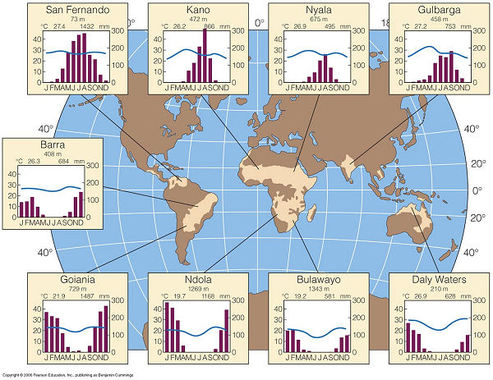The wet but dry climate of the savannas
The climate of savannas change throughout the year. During the summer seasons, there is rain that sometimes floods the savanna, but in the winter, there are droughts and fires beacause of the the dry weather.
Temperatures range from 20°C to 25°C in the winter and from 25°C to 30°C in the rainy summer. The temperatrue changes very gradually in the savanna and the changes are not large.
Rainy season (summer months):
During these seasons (which in West Africa, starts in May), the soil is replenished and all rivers will flow freely. However, in the Llanos Savanna, the river floods every year to enrich the land with nutrients. The average rainfall per year in the average savanna is 100 to 150cm of rain and in most savannas, during Dercember, January, and February (the dry months) there is hardly ANY rainfall.
Dry season (winter months):
During these months, many plants and grasses shrivel up and die and all local rivers may dry up due to the scarce rainfall. Near the end of this season, just before the rainy season starts, clouds bring nothing but lightning and the lightning hits the dry ground causing a fire to start. The fire rages across the savanna from a few days to even a few weeks, depending on when the first rainfall comes. The fire, however,enriches the soil and some animals uses the fire as an advantage.
Temperatures range from 20°C to 25°C in the winter and from 25°C to 30°C in the rainy summer. The temperatrue changes very gradually in the savanna and the changes are not large.
Rainy season (summer months):
During these seasons (which in West Africa, starts in May), the soil is replenished and all rivers will flow freely. However, in the Llanos Savanna, the river floods every year to enrich the land with nutrients. The average rainfall per year in the average savanna is 100 to 150cm of rain and in most savannas, during Dercember, January, and February (the dry months) there is hardly ANY rainfall.
Dry season (winter months):
During these months, many plants and grasses shrivel up and die and all local rivers may dry up due to the scarce rainfall. Near the end of this season, just before the rainy season starts, clouds bring nothing but lightning and the lightning hits the dry ground causing a fire to start. The fire rages across the savanna from a few days to even a few weeks, depending on when the first rainfall comes. The fire, however,enriches the soil and some animals uses the fire as an advantage.
Above is a climate graph of many places in savannas around the world. You can see that the places shown all have a clear dry and rainy season. The temperature doesn't change much either.

